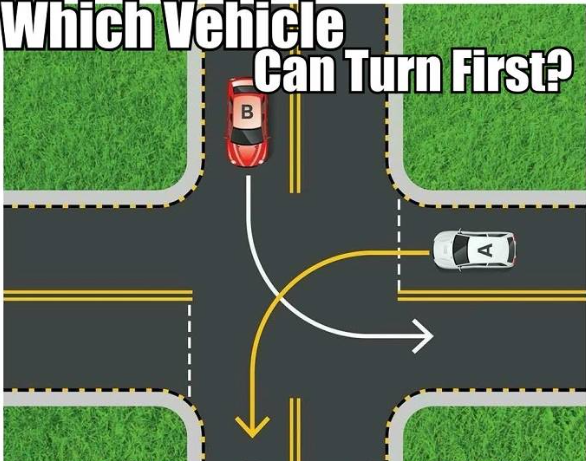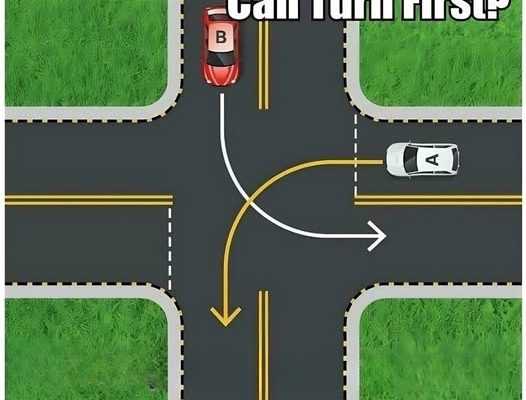Driving is a skill we use daily, but every now and then, we come across scenarios that make us pause and think. Imagine this situation: two cars approach an intersection without any signs to indicate who should go first. One car is white (Car A) and the other is red (Car B). Can they both turn at the same time? Or should one car wait? Let’s break it down, analyze the scenario, and settle this traffic conundrum once and for all.

The Scenario: A Simple Yet Tricky Intersection
Picture this: two vehicles approach an intersection, and there are no stop signs, yield signs, or traffic lights to guide them. However, the road is marked with dotted lines—an important detail that helps us understand how to proceed.
Car A (white) and Car B (red) arrive at the intersection at roughly the same time. Both cars are positioned to make a turn. So, who has the right of way? And more importantly, is it possible for both vehicles to turn at the same time?
Understanding the Basics: What Do the Dotted Lines Mean?
First, let’s decode the road markings. The dotted lines indicate a boundary or lane division. They also act as a visual cue for drivers to proceed cautiously and allow others to pass when necessary. In this situation, the dotted lines suggest that one car must give way to the other.
When two vehicles approach an intersection without signs or signals, basic traffic rules come into play. These include concepts like yielding to the car on the right or understanding the flow of traffic based on road markings.
Can Both Cars Turn Simultaneously?
Here’s where things get tricky. At first glance, it might seem possible for both cars to make their turns at the same time. After all, they’re both trying to navigate the intersection. But let’s consider the risks.
If Car A (white) and Car B (red) both attempt to turn simultaneously, they face a high likelihood of colliding. Why? Because the turning radius of both vehicles may overlap, especially in a tight intersection. Without proper coordination, this can result in an accident.
The solution? One car must yield to the other to ensure a smooth and safe flow of traffic.
Who Has the Right of Way?
Now comes the moment of truth: which car should go first?
Based on the dotted lines and basic traffic rules, Car A (white) must wait for Car B (red) to pass first. Here’s why:
The dotted lines act as a boundary that requires Car A to yield to oncoming traffic.
Car B, which does not have to cross a dotted line, is already positioned to proceed through the intersection.
This means Car B has the right of way, and Car A must wait. Once Car B has safely passed, Car A can make its turn without risking a collision.
What Would You Do in This Situation?

Let’s take a moment to reflect on what you would do if you were in this scenario. Would you instinctively yield to the other car? Or would you hesitate, unsure of the rules?
Driving requires split-second decisions, but understanding basic traffic laws can make these moments less stressful. By paying attention to road markings like dotted lines and recognizing the flow of traffic, you can navigate intersections with confidence and avoid accidents.
Key Takeaways for Safer Driving
This simple yet thought-provoking scenario teaches us a few valuable lessons about driving:
- Pay Attention to Road Markings: Dotted lines, solid lines, and other markings provide critical information about how to proceed at intersections. Always take note of them.
- Yield When Necessary: If there are no signs or signals, use common sense and basic traffic rules to decide who has the right of way. In general, yield to oncoming traffic or the vehicle on your right.
- Avoid Simultaneous Turns: Even if it seems possible, avoid making turns at the same time as another vehicle. It’s better to wait a few seconds than risk a collision.
- Stay Calm and Alert: Driving can be unpredictable, but staying calm and aware of your surroundings will help you make better decisions.
Answer: Car B Has the Right of Way
In this scenario, the correct answer is clear: Car B (red) has the right of way, and Car A (white) must wait. The dotted lines serve as a visual reminder that one vehicle must yield to the other. By following this rule, both drivers can navigate the intersection safely and efficiently.
Did You Enjoy the Challenge? Share It with Friends!
This fun driving scenario is more than just a test of your traffic knowledge—it’s a reminder of the importance of staying sharp on the road. Whether you’re a seasoned driver or just starting out, challenges like this help reinforce essential rules and keep you prepared for real-world situations.
So, did you guess the right answer? If you enjoyed this challenge, share it with your friends and see how they fare. After all, a little friendly competition never hurt anyone! Safe driving, everyone!



